Lord Muck's Blog
November 20, 2016
I’ve had a pond in my garden for a good twenty years. When the children were small the space had a thick concrete cap on it, reputedly the base of a war-time Anderson shelter. It served the very useful purpose of hosting a children’s sandpit without them getting hopelessly muddy. But children grow up and the sandpit was no longer a necessary part of the garden. But a pond seemed like a good idea. While having some other work done on the house the builders broke up the concrete and dug a pond. Its been a good one and the frogs have enjoyed it a lot, spawning every year. But that Anderson shelter was where it was because there was plenty of earth – an earth bank at the end of the garden; and over the years the earth has gradually slithered into the pond. Pond and steep bank were incompatible, so as part of my garden makeover this year I resolved to move it. Second week in October was pencilled in as the time to do it – at a time when the frogs were neither so small as to be unable to make their escape nor hibernating at the bottom to escape the cold of winter, but rather roaming the garden and sheltering in damp places like the compost heap, while feeding on slugs and other garden pests.
Pond moving requires quite a lot of digging, so in the end I decided to shift it out of the line of fire of that collapsing bank, but not to relocate it entirely. 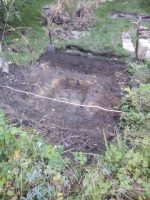 After all it wouldn’t do if the frogs lost their bearings. So come mid-October and I’m processing the very recent death of my mum and pond renovation seems as good a way as any to do it.
After all it wouldn’t do if the frogs lost their bearings. So come mid-October and I’m processing the very recent death of my mum and pond renovation seems as good a way as any to do it.
Its quite a palaver. Emptying the pond of weed, mud and all that earth and stone that shouldn’t be in it; digging out the new pond profile; replacing the lining and the linings protection; securing it with stone and sod; refilling it and finally returning some pond plants.
securing it with stone and sod; refilling it and finally returning some pond plants. Now, stand back be patient and await the frogs return.
Now, stand back be patient and await the frogs return.
October 25, 2016
My mum Clare Stott, died a couple of weeks ago aged 94. Her funeral is tomorrow. There are many things I remember her for, but one of the most consistent threads in our lives was the shared passion in plants and growing. We moved to the house in north Oxfordshire that became the family home, in 1960 and in which she died fifty six years later. At the time my parents bought it, the house had been abandoned for some years and was only accessible from the nearby village of Wootton near Woodstock across the fields. The cottages were on a hilltop overlooking a spectacular view of the Glyme valley.  Earliest memories are of my parents trying to create a garden from a steep hillside covered with limestone. Corn brash soil strictly speaking. The only way to create a cultivatable garden was to construct walls and paths out of the huge quantities of stone, and carve out little beds for plants in between. That engagement between slope, stone and soil was the basis of their gardening, and a major influence on mine. Garden structure was crucial, and from an early age I was taught how to construct traditional Cotswold dry stone walls from the materials readily available. Holding the other end of the lines and pegs while my dad Frank measured and used a level to design the network of steps linking paths, patches of lawn, and the arches and gates in walls that were to make up the garden was another formative experience.
Earliest memories are of my parents trying to create a garden from a steep hillside covered with limestone. Corn brash soil strictly speaking. The only way to create a cultivatable garden was to construct walls and paths out of the huge quantities of stone, and carve out little beds for plants in between. That engagement between slope, stone and soil was the basis of their gardening, and a major influence on mine. Garden structure was crucial, and from an early age I was taught how to construct traditional Cotswold dry stone walls from the materials readily available. Holding the other end of the lines and pegs while my dad Frank measured and used a level to design the network of steps linking paths, patches of lawn, and the arches and gates in walls that were to make up the garden was another formative experience.  Perhaps unsurprisingly in the context, they were both active in the Alpine Garden Society and early memories include plenty of small alpines being planted, especially in the walls, paths, and nooks and crannies on steps. Equally unsurprisingly they they gravitated towards other such gardeners and garden designers.
Perhaps unsurprisingly in the context, they were both active in the Alpine Garden Society and early memories include plenty of small alpines being planted, especially in the walls, paths, and nooks and crannies on steps. Equally unsurprisingly they they gravitated towards other such gardeners and garden designers.
One was Margery Fish, author of ‘We made a garden’, and I well recall a visit to her house and garden in East Lambrook in Somerset as a child. What a charming old lady she was! And what an amazing garden, helped of course by the house being the village manor house. The book, published sixty years ago, records her struggles both with the terrain and soil, but also (especially) with her husband Walter (long since dead by the time we visited in the 1960’s) who perhaps predictably as the ex-Editor of the Daily Mail, had a view of gardening as something where plants and lawns were to be controlled and tamed. Not so Margery Fish, who whose attempts to break up the symmetry of his paths with ‘tiny green plants that would creep along all the stones’ had to await his departure, where upon ‘…a lot of the Somerset cement became loosened, some of  it helped, I admit by a crowbar..’ and ‘now I have little plants creeping and crawling out of nearly every crevice..’ Just like my parents garden, to which she paid a return visit to much to my mum’s delight.
it helped, I admit by a crowbar..’ and ‘now I have little plants creeping and crawling out of nearly every crevice..’ Just like my parents garden, to which she paid a return visit to much to my mum’s delight.
Walls need plants growing up them, and paths need to lead somewhere, often to openings in the walls, with arches. Wisteria on the walls of the cottages, clematis especially a white one covering an arch, and red tulips in a long border running down the side of the dry stone wall that marked the edge of the orchard, were some of her favourite plants. Perhaps the rather unrelenting nature of the soil – if that is what you could call all that stone, led to a particular delight in winter flowering plants – grey stone, mist, leafless trees and bursts of colour; cyclamen in drifts across the lawns, were definitely a favourite. The interaction between stone, foliage, garden ornament – the stone cockerel, the sundial on its stone plinth, the pond with its little statue and tiny stream of running water,  bounded by an old stone wall that preceded our arrival and separated garden from orchard and field beyond. All in all it was an interpretation of the traditional ‘cottage garden’ (after all it was a garden round two old and converted cottages…) designed for the circumstances; a largely north facing slope where the views across the Glyme and towards the small village of Wootton clinging to the valley on the other (south facing) side were as much of an attraction as the content of the garden itself.
bounded by an old stone wall that preceded our arrival and separated garden from orchard and field beyond. All in all it was an interpretation of the traditional ‘cottage garden’ (after all it was a garden round two old and converted cottages…) designed for the circumstances; a largely north facing slope where the views across the Glyme and towards the small village of Wootton clinging to the valley on the other (south facing) side were as much of an attraction as the content of the garden itself.
Space, colour (the rose garden especially), views, garden as separate ‘rooms’ bounded by ancient walls with openings and arches, climbers, foliage and occasional carefully positioned trees and shrubs were its signatures. Room for vegetables and compost heaps? Certainly, but the kitchen garden had it place by the garage, not for daily contemplation. Strategically placed compost heaps were screened by annuals and clematis climbing over low walls, within striking distance of the kitchen, but just out of sight of the kitchen window. I won’t say that my own garden in the middle of a city and just 67 by 26 foot replicates much of this, but the learning is there, and for that I am very grateful.
September 8, 2016
Last weekend I was invited to speak at a conference in Bristol to celebrate the 40th anniversary of the publication of the book ‘Radical Technology’ edited by Pete Harper and Godfrey Boyle. It was part nostalgia, part reflection on what we got right, or didn’t and and the lessons learned, and partly some visioning of the future. Naturally the book focussed on themes current in the 1970’s; food, energy, shelter, materials, communications and a rather mysteriously entitled, ‘autonomy’ as well as macrobiotics, the occult, and 19c utopias. I was there to reflect on Lawrence Hills’ contribution on the role of composting in organic growing. Hills was the founder of HRDA, now Garden Organic and by the mid 1970’s had already achieved a certain guru status. One of the original editors told me they were really pleased when he agreed to contribute. I suspect he was their oldest contributor. One of the big themes of the time was rural self-sufficiency, strongly influenced by the writings of John Seymour such as ‘Self Sufficiency’ (1973). Looking back, with sustainability and ‘carbon footprints’ more to the fore these days, the rural idyll looks remarkably self indulgent and unsustainable. High density, low carbon footprint cities are where its at. Unlike some of the other contributions Hills’ article is highly practical. He focuses on organic gardening – of course, but starts off by saying: ‘Anything written on organic gardening must begin with making a compost heap’. Anyone blogging as Lord Muck could hardly disagree.
The tenor of the article has survived the passage of time well – composting and organic growing are pretty timeless after all. I love his analogy; ‘Compost making is like baking bread – there are many methods but all are ways of using bacteria and fungi to make a product we want – compost is as ‘unnatural’ as a flint axe, a loaf of bread, a glass of beer or a chunk of cheese.’ It is written in very much what I imagine to be Lawrence’s ‘voice’ (I never knew him, he died in 1990) advocating ‘household liquid activator’ ie urine mixed with three parts water to get the composting processes going, allegedly at the time called ‘Chairman Mao’s favourite’ (I doubt it. Chairman Mao was no gardener, far too posh) and as a pest control spray ‘…nicotine, made by simmering 2oz of filter tip cigarette ends (ask your local cinema if you are a non smoker) in a quart of water for half an hour filtering through a cloth and diluting with six parts of water for aphids and four for cabbage caterpillars’. Priceless. Which cinema, and what cigarette butts? A fascinating little insight on how social and societal mores have changed in 40 years.
The funny thing is, Hills was chiefly famous in his time for advocating the use of comfrey, certainly something I adopted with enthusiasm in the late 70’s and still have plenty of on both allotment and garden, but it doesn’t get a mention in his contribution to ‘Radical Technology’. A few other things didn’t get mentioned in the ‘food’ section of the book either. Nothing on fairtrade, nothing on animal rights (though the article on vegetarianism did make passing reference to killing animals being a good reason for being one), nothing on selling as opposed to growing food, nothing on the role of multi-national food corporations (though there was a prescient piece by Charlie Clutterbuck who also spoke, on agri-business), nothing on the Common Agricultural Policy and its implications, though the book came out only months after an in/out referendum on EEC membership produced a decisive remain result… how things change; and perhaps most oddly of all, nothing on food and health. Obesity wasn’t the big issue it is now, but John Yudkin’s book ‘Pure, white and deadly’ on the dangers of sugar had been out for four years. The focus was really on addressing issues of equality, tackling the global food crisis, environmental sustainability (not called that then) and health, by growing your own. That is still important, but everybody at last weekends conference was only too well aware of the bigger picture issues too. At the time ‘Radical Technology’ was written, salmonella in eggs and other food safety issues, including food irradiation, and BSE, as well as the whole GM debate, were all in the distant future.
July 6, 2016
So it looks as if the UK will definitely be leaving the EU ….sometime. This historic moment has prompted me think about what our ‘national vegetable’ might be in these turbulent times. And being as the times are so turbulent, what the constituent national vegetables of the nations in the British Isles might be, as we go our separate ways. Lets start with the easy one; Wales. They already have a national vegetable, the leek. A good choice, so easy to grow, tasty, versatile and nutritious. But officially.. no other nation has such a vegetable. So here goes with some suggestions. Scotland. The national dish, haggis, is normally eaten with ‘neeps and tatties’. Far from being turnips, ‘neeps’ are actually swedes. Understandably popular on Burns Night which falls in January when there isn’t a lot else around – but hardly a vegetable to set the heart racing. How about a variation on the national flower, the thistle? The cardoon perhaps? or the artichoke? Looks much better on the menu of a swish Edinburgh eatery. Ireland? The obvious suggestion is the potato and indeed there a is even a ‘Tayto’ theme park in the Republic and the internet swirls with articles of the ‘Thirteen reasons why the potato is the Irish national vegetable’ – variety. But the potato is a staple, and redolent with the suffering of the Famine of the 1840’s. Hardly something to celebrate. How about the garden pea? There are some good Irish-sounding varieties like the Danny O’Rourke. And it is popular in Ireland. For the traditionalist perhaps caragheen, gathered from the seashore and popular in seafood restaurants might command support? The cabbage too has its supporters. After all colcannon or ‘champ’ made with cabbage and potato and often eaten with sausages, is a classic Irish dish, north and south. Would the North have its own? Hmmm… Didn’t someone once say ‘oranges are not the only vegetable’, or something like that. Lets move on. England. So many vegetables, so many contenders. From the root vegetable world, lets hear it for the carrot, and the parsnip. Such classics of English cuisine. For the more advanced palate the asparagus perhaps? A reminder of Spring, ready from St George’s Day. But perhaps that is its problem; too seasonal. Of course the English regions are asserting themselves these days too. So how about the ‘national’ vegetable of Yorkshire. Rhubarb obviously. Yorkshire, home of the ‘rhubarb triangle’. Most people think it is fruit, but it isn’t. Isle of Wight? Not independent yet, but who knows. Home of England’s only garlic festival, it has to be garlic. But who wears the crown of being England’s truly national vegetable? Something we have as part of the traditional Christmas dinner perhaps. Maybe the roast potato, but the potato is too closely associated with Ireland to really work; parsnip is definitely a contender, but what else graces the Christmas platter? Why the brussels sprout of course. Step forward…. the English national vegetable. Eat your heart out Nigel Farage, those perfidious Europeans have triumphed again.
June 6, 2016
To misquote American radical journalist Lincoln Steffens’ famous aphorism after his visit to the Soviet Union in 1919 (he later recanted). Last year when writing my Cowley Road Cookbook I forecast that the next big global trend to hit the Cowley Road food scene would be insects. Two billion people world wide are eating insects as part of their normal diet already, and I speculated that the arrival of entomophagy on Cowley Road couldn’t be far away. And sure enough Science Oxford hosted a bug banquet at the Pegasus Theatre over the weekend. Two in fact. Some twenty two people paid to come along, about half were children. Quick quiz. Who had eaten insects before? Only two hands went up, mine being one. Where? ‘In China.’ we both said.
And off we went. Starting with a short video from the BBC’s Living Planet series on children catching and eating tarantulas in the an unspecified jungle location. The size of dinner plates they say. Cook them over an open fire until all the dangerous hairs are burnt off and ‘they taste like crab’ – apparently. Back at the Pegasus nothing so ambitious. Actual cooking was out for a start, but we were served up with a kind of ‘tasting menu’ of little creatures; mealworms, (see picture) grasshoppers, ants, silkworm pupae, crickets and locusts. To be honest the mealworms taste like pringles; the crickets are better, a sort of coconut chip flavour, and the locusts are by far the most interesting; slightly fishy, crunchy, but the wings are a bit chewy. Yes that’s me eating one.
(see picture) grasshoppers, ants, silkworm pupae, crickets and locusts. To be honest the mealworms taste like pringles; the crickets are better, a sort of coconut chip flavour, and the locusts are by far the most interesting; slightly fishy, crunchy, but the wings are a bit chewy. Yes that’s me eating one. 
Being mainly aimed at children, presumably on the ‘get ’em young’ principle, the next part of the event was so so British it couldn’t be parodied. Cooking in a theatre? Never. ‘Elf and safety of course, but the Science Oxford team produced a tealight, some rubbers to balance it on and a little stand to to put your aluminum cupcake on for each table of excited adults and children, and it was the opportunity to melt some chocolate, throw in some dried berries/meringue pieces/candied cherries and your insects of choice. Locust dipped in chocolate anyone? It worked for some.
To round off was the ‘something I prepared earlier’, slot. Bug baking in all its glory. We got to sample huge platters full of banana bread …with added mealworms, chocolate truffles … with grasshopper, white chocolate fudge and ants, and my favourite, ‘chocolate chirp cookie’ with cricket. All very sweet, in both senses of the word. Next time something a little more spicy with a beer, like these ones in Beijing, perhaps.
All very sweet, in both senses of the word. Next time something a little more spicy with a beer, like these ones in Beijing, perhaps.
April 27, 2016
A few weeks ago I took a trip down to Camberwell in south east London to see my daughter on her birthday and visit her new flat. On checking the map and tube links I realised that one of the quickest ways to get there was by tube to Oval and then walk. The walk took me right past where I used to live in the 1970’s , the Brandon Estate in Walworth. I lived there from 1977-79 on the fifteenth floor of one of the massive tower blocks, Prescott House. By and large the experience was positive; the flat had fantastic views, was roomy, warm and quiet. I enjoyed the proximity to central London and got stuck into community politics including being co-editor of a fairly scabrious magazine ‘South Circular’, and secretary of my local Labour Party branch. Nonetheless the area then was very far from gentrified, and suffered from the attentions of the National Front. Indeed the only reason I and my flatmate got such a GLC flat in the first place was because it was ‘hard to let’. But it had a balcony on which we grew tomatoes in a gro-bag, and we had a Henry Moore in the garden. Yes really. In fact it was and still is, ‘Two piece reclining figure no3’ (1961). I remember being very struck by it; when we moved in the lifts didn’t function. It was half way through a protracted lift engineers strike so I had plenty of opportunities to view it from various heights and angles as I toiled up and down those fifteen flights of stairs.
The idea of a Moore sculpture in such a location was very much part of the post war approach to planning and community building. As well as three enormous tower blocks, the estate, designed by William Morris fan Ted Hollamby (so much of a fan indeed that he bought and lived in the Red House in Bexley, William and Jane Morris’s first house), included a range of modern streets, some older renovated ones, a church, pub, shopping centre, community hall and library. And that sculpture. Which was complemented as I recall, by a giant totem pole for in the centre of the children’s playground. The LCC was in the habit of commissioning such art works as the centre-pieces of its estates, but this one was which was installed in 1962 when the estate was completed, was at £8,000 by far the most expensive commission they had undertaken until then. Indeed Ted Hollamby was reportedly pretty annoyed as the shopping centre included a mural of the the Chartists meeting at Kennington on 10 April 1848, designed by him, which basically only got a fraction of that sum allocated for materials and installation.
Moore liked it and spent quite a bit of time coming up with different options for its installation. In an interview in Atlantic Monthly the year after its installation he said: ‘I realised what an advantage a separated two-piece composition could have in relating figures to a landscape. Knees and breasts are mountains.’ Almost forty years after I was living on the estate, the sculpture is still there and looking just as impressive as I walked through it in the gloaming of an early Spring evening. It made me realise that I still hanker after having a Henry Moore in my garden again.
February 29, 2016
In the 1770’s when the New Town was built to the north of the Old Town in Edinburgh, there was a mass movement of people from Old to New – abandoning the insanitary courtyards and tenements of the medieval city for the glories of the new Georgian squares and circuses. It was known as ‘the great flitting’. It is hardly on the same scale, but this weekend saw my great flitting. After 28 years on my allotment plot I moved. Call it downsizing, call it pragmatism, even the effects of getting older perhaps. But having a garden, an allotment down to fruit trees, and another for vegetables, as well as a share of a poly tunnel, was beginning to feel like too much. After all, daughters flew the nest some yeas ago, partner Sue has her own allotment in Bristol, which I also loyally help with, and the plan is to spend more time growing veg in the garden. So that veg plot was beginning to look like outdoor housework – or at best, a way of growing far more than I could possibly consume, and then wondering why I did it after giving three quarters of it away (pleasurable thought that can be). Decision made last autumn, to consolidate on just one plot – the orchard.
Making the move will take time. The orchard is mass of trees (!) and a lot of grass between them. A couple of years ago the City Council, after pressure from plot holders because of repeated flooding of the site, spent time laying drainage pipes (see my blogs on the susceptibility of my old plot to flooding, and the councils work on the orchard one). They go right across my orchard plot and in doing so took out most of the hedge. So now there is much more space; space where the hedge was and space opened up between the trees, space to dig and turn into a series of mini plots, just right for the fugitive veg. Digging out the remaining hedge roots, the ivy all over the ground, and prepping up new beds is the really time consuming bit, but progress is being made. The symbolic moment to is that move of tools and equipment from one plot to the other – and the shed to put them all in.
In the USA there is a tradition of the whole village turning out to assist in the local farmers ‘barn raising’.  A couple of blokes can never do it on their own, it is a communal effort, with much merrymaking at the end of a hard days work, and a farming family standing proudly in front of their new barn. Here its much the same if on a smaller scale. So come Saturday, the allotment association work party gathered, the shed assessed, carrying poles rustled up and the work began.The shed is over 40 years old. They made ’em different in them days. None of this flimsy planking held together with glorified staples. This shed is solid – it has survived several moves since I acquired it, second hand, in 1980. So first reactions of the ‘Oh, I think we can manage this with four’, one person at each corner, soon proved wide of the mark.
A couple of blokes can never do it on their own, it is a communal effort, with much merrymaking at the end of a hard days work, and a farming family standing proudly in front of their new barn. Here its much the same if on a smaller scale. So come Saturday, the allotment association work party gathered, the shed assessed, carrying poles rustled up and the work began.The shed is over 40 years old. They made ’em different in them days. None of this flimsy planking held together with glorified staples. This shed is solid – it has survived several moves since I acquired it, second hand, in 1980. So first reactions of the ‘Oh, I think we can manage this with four’, one person at each corner, soon proved wide of the mark.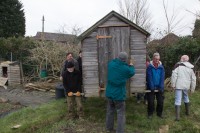 In the end it was eleven; six on the three steel poles, two more front and back, and one out front (not me) issuing instructions and clearing a safe path. All in all it took about 30 minutes to move first the base and then the superstructure and put the back together 300 metres away on the new plot. Incredibly the shed was so sturdy and the move so careful, that when the superstructure was gently laid back on the base, the screw holes for the metal brackets slotted straight back. It could all be screwed back together using the same screws. Result: barn raising allotment-style achieved.
In the end it was eleven; six on the three steel poles, two more front and back, and one out front (not me) issuing instructions and clearing a safe path. All in all it took about 30 minutes to move first the base and then the superstructure and put the back together 300 metres away on the new plot. Incredibly the shed was so sturdy and the move so careful, that when the superstructure was gently laid back on the base, the screw holes for the metal brackets slotted straight back. It could all be screwed back together using the same screws. Result: barn raising allotment-style achieved. 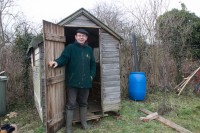 Thanks friends and fellow plot holders. Come a summer evening, the drinks are on me.
Thanks friends and fellow plot holders. Come a summer evening, the drinks are on me.
January 18, 2016
It is that time of year when New Years resolutions are made and broken. I know this because the yoga class I go to is always packed out in January. It thins out by mid-February though. Also there are lots of books published around Christmas which have an agenda – to make the reader ‘do something’; take up a new past time, de-clutter, or this year’s hit … be mindful. So ‘The Ladybird Book of Mindfulness’ seemed the obvious place to start. ‘Muck and mindfulness’ … has a ring to it; might be a good title for a blog some day. Amazingly my alter ego, Martin features heavily in this book. ‘By practicing mindfulness, Martin has found his inner peace, even though he is being kidnapped by swans.’ Exciting thought, and there is even a lovely picture of Lord Muck on some kind of throne heading skywards with a flock of swans clutching silken ropes in their beaks. Other parts of the book are a bit darker. ‘Clive likes to practice loving kindness meditation…Clive finds this easier than bothering to meet his friends or lend them money.’ Even more alarmingly, ‘Mindfulness has taught Leanne to accept things as they are; rubbish, expensive, unfair and out of date every six months.’ That sound suspiciously like a description of a new years resolution to me.
So does mindfulness involve buying lots of soon to be out of date stuff? All those colouring books, relaxation tapes and tracts on how to be mindful. Well yes…the implication is that purchasing them and retiring to your room to spend time with them is the path to something sacred and special, unless that is, you can afford to retire to a mountain top to practice, which is even better…. and even more expensive. All very West Coast/Marin County; something I satirised in ‘Spilling the Beans’, some 30 years ago. It is the notion that you need to ‘find time’ to meditate that really grates. Usually that actually means stopping looking after the kids or something else you want to duck out of. Not being one for the sacrilising approach, my ‘mantra’ for the past few decades has been ‘the meditation of every day life’. And what pray does that mean when its at home? Well, speaking of home… doing the washing up, cleaning the hens, hanging out the washing (my favourite, on a warm spring day… nothing better) hoovering (there is a certain strange joy to hearing those bits of dirt rattling up the nozzle and into the bag) and putting all the kitchen waste onto the compost, knowing that without doing a thing, it will be ready to spread round those vegetable seedlings in three months. That’s the joy isn’t it, knowing that you don’t have to do a thing – sun and wind will dry the washing and worms and insects will do their composty bit. As the Buddhist saying has it; ‘Don’t just do something; sit there’.
December 30, 2015
I had a real pre-Christmas treat visiting my eldest daughter and her partner in Edinburgh. Living in the New Town just below Calton Hill, their neighbourhood restaurant is somewhere called ‘Gardener’s Cottage’. Like the rest of that part of the New Town, said cottage was built in 1836 by William Playfair and is located in Royal Terrace Gardens, where unsurprisingly the original purpose of the building was to be … the gardeners cottage. The gardens still look great, but they are maintained by Edinburgh Corporation these days, and the cottage was for many years abandoned and in a ruinous state. Until a few years ago when the council reckoned that really it ought to be demolished, but as it was a listed building, it couldn’t be. A competition for a new use; and the winners were a couple of chefs Dale Mailley and Edward Murray who opened their new restaurant in 2012. It was an immediate hit with the critics and the locals. The concept is simple. Very simple. 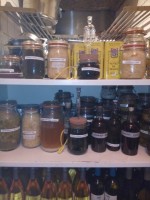 Three trestle tables seating 10 each, one in a small room and the other two in the main dining room which has the kitchen off it – no larger than many household kitchens. The Lord Muck party end up in the wee room, whitewashed walls, and dressers piled high with jars and bottles;
Three trestle tables seating 10 each, one in a small room and the other two in the main dining room which has the kitchen off it – no larger than many household kitchens. The Lord Muck party end up in the wee room, whitewashed walls, and dressers piled high with jars and bottles;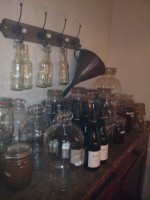 ‘Rowan jelly 5 October 2015’, ‘Plum jam 2 October 2015’, ‘Beetroot kvas 25 may 2105’, ‘salted pears’… artfully artistic meets practical. The entrance lobby is just the same, rows of neatly shelved and labelled bottles and jars. The trestle tables are bare and the candles are in pewter candlesticks. The apogee of hippy sophistication. The tables lend an up close and personal dimension to the dining experience too as diners share space and condiments – and even the occasional alcoholic top-up. And .. the food. It is rather wonderful to walk up the short gravel path to the restaurant between rows of home grown veg, right there in the city centre. Brassicas, salad crops, and herbs all very much in evidence.
‘Rowan jelly 5 October 2015’, ‘Plum jam 2 October 2015’, ‘Beetroot kvas 25 may 2105’, ‘salted pears’… artfully artistic meets practical. The entrance lobby is just the same, rows of neatly shelved and labelled bottles and jars. The trestle tables are bare and the candles are in pewter candlesticks. The apogee of hippy sophistication. The tables lend an up close and personal dimension to the dining experience too as diners share space and condiments – and even the occasional alcoholic top-up. And .. the food. It is rather wonderful to walk up the short gravel path to the restaurant between rows of home grown veg, right there in the city centre. Brassicas, salad crops, and herbs all very much in evidence.  Some serious cultivation – in December. The menu reflects this, local, seasonal, home grown, quite a bit of foraging nothing remotely ‘sourced’ from a catering wholesaler. Not much in the way of choice, but flexibility for vegetarians. A ‘tasting menu’ approach, so seven courses served (there was a little bit of nervousness about quantities from one member of the party, and jokes about will we need to stop by for fish and chips on the way home.. all entirely unfounded); oyster tempura to start, something fairly amazing with mushrooms and crispbread, a serving of hake with kale leaves (almost certainly from the garden) and slithers of potato, a ‘cheese course’ consisting of whipped goats cheese served up in a tiny cornet made from ‘ground burnt leek’ with a piece of toasted beetroot as the ‘flake’, poached pears and chestnut with ice cream dessert. Mind you, serving up a dish with Jerusalem artichokes as its base, is a recipe for distinct indigestion. The drinks menu was a masterpiece of inventiveness including a local micro- brewery beer, ‘fig pucker’ (think David Cameron’s student exploits…. actually no, don’t) and something stronger, brewed with local foraged berries; the makers of both known personally to other members of the Muck party.
Some serious cultivation – in December. The menu reflects this, local, seasonal, home grown, quite a bit of foraging nothing remotely ‘sourced’ from a catering wholesaler. Not much in the way of choice, but flexibility for vegetarians. A ‘tasting menu’ approach, so seven courses served (there was a little bit of nervousness about quantities from one member of the party, and jokes about will we need to stop by for fish and chips on the way home.. all entirely unfounded); oyster tempura to start, something fairly amazing with mushrooms and crispbread, a serving of hake with kale leaves (almost certainly from the garden) and slithers of potato, a ‘cheese course’ consisting of whipped goats cheese served up in a tiny cornet made from ‘ground burnt leek’ with a piece of toasted beetroot as the ‘flake’, poached pears and chestnut with ice cream dessert. Mind you, serving up a dish with Jerusalem artichokes as its base, is a recipe for distinct indigestion. The drinks menu was a masterpiece of inventiveness including a local micro- brewery beer, ‘fig pucker’ (think David Cameron’s student exploits…. actually no, don’t) and something stronger, brewed with local foraged berries; the makers of both known personally to other members of the Muck party.  Ours was a late evening booking so by the time the ‘petit fours’ had been consumed it seemed wiser to retire back to base and drink our own Calvados. But what a spot, an island of simple sophistication in what can be a pretty crazy city.
Ours was a late evening booking so by the time the ‘petit fours’ had been consumed it seemed wiser to retire back to base and drink our own Calvados. But what a spot, an island of simple sophistication in what can be a pretty crazy city.
December 28, 2015
For me, two books published this year have taken different and inspiring approaches to the weather and the outdoors. As we watch water cascading down the very streets in Yorkshire that the British leg of the Tour De France traversed just last year, Jon Day’s Cyclogeography: journeys of a London bicycle courier (Notting Hill Editions) chronicles the unforgiving nature of the messengers existence on the fringes of society, while at the same time examining the physical dimensions of the journey itself; gradients, road surfaces, wind, rain and the way the bike wants to flow down hill following the ancient ley lines of the city’s subterranean rivers. Alexandra Harris, Weatherland: writers and artists under English skies (Thames & Hudson) is an ambitious literary and cultural history, the story of the stories that people have told each other about the weather across the millennia from Anglo-Saxon scribes to Virginia Woolf and Zadie Smith. As the weather we have associated with the British Isles begins to change irrevocably, she reveals the great storehouse we carry in our minds; the names we find for the hail, the wind and the mist, the traditions of the seasons, the Frost Fairs and the riddles.
A shorter version of this blog first appeared in the review section of The Guardian on 26 December 2015.
 After all it wouldn’t do if the frogs lost their bearings. So come mid-October and I’m processing the very recent death of my mum and pond renovation seems as good a way as any to do it.
After all it wouldn’t do if the frogs lost their bearings. So come mid-October and I’m processing the very recent death of my mum and pond renovation seems as good a way as any to do it. securing it with stone and sod; refilling it and finally returning some pond plants.
securing it with stone and sod; refilling it and finally returning some pond plants. Now, stand back be patient and await the frogs return.
Now, stand back be patient and await the frogs return.













